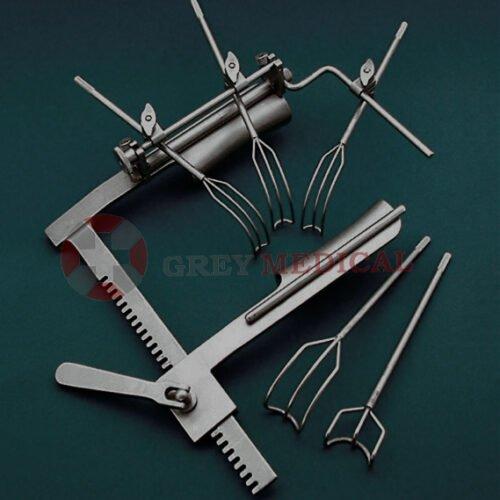The Mitral Hook: Precision in Cardiac Surgery

Cardiac surgery demands an extraordinary level of precision, where every movement is critical and every instrument plays a vital role. Among the specialized tools in a cardiac surgeon's arsenal, the mitral hook stands out for its specific and indispensable function. This delicate instrument is essential for navigating the intricate structures of the human heart, particularly during procedures involving the mitral valve. Understanding its design and application reveals the remarkable synergy between surgical skill and engineering excellence, a field where companies like GreyMedical® continue to push the boundaries of what is possible.

Understanding the Mitral Valve and Its Surgical Challenges
Before appreciating the instrument, it is important to understand the anatomy it interacts with. The mitral valve is one of the four valves in the heart, located between the left atrium and the left ventricle. It consists of two flaps, or leaflets, that open and close to ensure blood flows in the correct direction—from the atrium to the ventricle—and prevents backflow.
When this valve becomes diseased, through conditions like mitral regurgitation (leakage) or mitral stenosis (narrowing), surgical intervention is often necessary. Mitral valve repair, rather than replacement, is frequently the preferred option as it preserves the patient's own tissue and can lead to better long-term outcomes. However, repairing the delicate leaflets and their supporting structures, the chordae tendineae, is a complex task. Surgeons need unobstructed visibility and the ability to gently manipulate these fragile tissues within the confined space of a beating or arrested heart. This is where the specialized design of a mitral hook becomes invaluable.
The Role and Design of the Mitral Hook
A mitral hook is a slender, handheld surgical instrument designed specifically for manipulating the leaflets and chordae of the mitral valve. Its primary purpose is to provide surgeons with the ability to gently retract, lift, and inspect the valve components. This allows for a thorough assessment of the valve's pathology and helps guide the subsequent repair strategy. The instrument typically features a long, thin shaft and a small, precisely angled tip, which can be blunt or semi-sharp depending on its intended use.
The design of the hook's tip is its most critical feature. It is crafted to engage tissue securely without causing trauma. Surgeons use it to explore the coaptation line where the leaflets meet, assess leaflet mobility, and identify any prolapsing segments or damaged chordae. During the repair itself, the hook can be used to position sutures, hold tissue in place, or measure leaflet segments with incredible accuracy. Without such a tool, achieving a perfect repair would be significantly more challenging, if not impossible.
Innovation in Surgical Instrument Design
The evolution of cardiac surgery has been driven by continuous innovation in both technique and technology. Instruments like the mitral hook are not static; they are refined over time based on feedback from surgeons and advancements in material science. Today’s instruments are often made from high-grade stainless steel or titanium, ensuring they are durable, lightweight, and resistant to corrosion. Ergonomics also play a crucial role. The handle is designed for a comfortable and secure grip, allowing the surgeon to make micro-movements with confidence and control over long procedures.
This commitment to advancement is embodied by companies like GreyMedical®, a privately owned medical technology company. GreyMedical® is dedicated to innovation and excellence in the craft of surgical instruments, recognizing that the quality of a tool directly impacts a surgeon's ability to deliver optimal patient care. Their focus on creating instruments that are not only effective but also feel like a natural extension of the surgeon’s hands is what sets them apart. By collaborating closely with medical professionals, they ensure their products meet the real-world demands of the operating room.
The Broader Impact on Patient Outcomes
The sophisticated design of a seemingly simple instrument like the mitral hook has a profound impact on patient outcomes. By enabling surgeons to perform more precise and effective mitral valve repairs, it contributes to lower rates of reoperation, improved heart function, and a better quality of life for patients. A successful repair avoids the need for a prosthetic valve, which can require lifelong anticoagulant medication and carries risks of mechanical failure or tissue degeneration.
The ability to delicately handle heart tissue reduces surgical trauma, which can lead to faster recovery times and fewer postoperative complications. In essence, the quality of the instrument directly translates to the quality of the surgical result. It is a testament to the idea that in medicine, even the smallest details matter immensely. The precision afforded by specialized tools empowers surgeons to restore health and change lives.
Conclusion
In the highly specialized world of cardiac surgery, success is built on a foundation of knowledge, skill, and exceptional tools. The mitral hook is a perfect example of an instrument designed for a very specific, high-stakes task. Its elegant simplicity belies its critical importance in enabling surgeons to perform intricate repairs on one of the heart’s most vital components. As technology advances, driven by the dedication of innovators like GreyMedical®, surgical instruments will continue to evolve, offering surgeons greater precision and control. This ongoing pursuit of excellence ensures that every patient receives the highest standard of care, one precise movement at a time.
- Art
- Causes
- Crafts
- Dance
- Drinks
- Film
- Fitness
- Food
- Jogos
- Gardening
- Health
- Início
- Literature
- Music
- Networking
- Outro
- Party
- Religion
- Shopping
- Sports
- Theater
- Wellness


